|
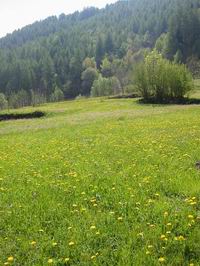 The valley develops from east to west and has a longitudinal aspect which is the most extended one in the whole Alpine arc. It is totally crossed by the National road number 38, known as "Statale dello Stelvio". The valley develops from east to west and has a longitudinal aspect which is the most extended one in the whole Alpine arc. It is totally crossed by the National road number 38, known as "Statale dello Stelvio".
The land is prevalently mountainous, with peaks reaching 4000 metres which frame the bottom of the valley. 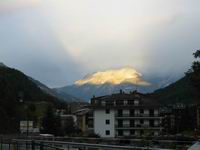 The River Adda that flows into the lake Como runs through the valley. The River Adda that flows into the lake Como runs through the valley.
The landscapes characterizing the province of Sondrio are varying and charming in every season of the year. You start with Valchiavenna, which is situated in the furthermost western part of Valtellina and is particularly popular thanks to the "crotti" and the beauty of its main town, Chiavenna; then you pass through the Bassa Valle surrounding Morbegno, the town from which the popular Bitto cheese originates. The terraced viticulture and the renowed cellars are characteristic of the area of Sondrio and Valmalenco, as far as Tirano and Teglio – this last one, the birthplace of pizzocheri. The journey discovering Valtellina ends in Alta Valle, with the termal baths in Bormio and the summer skiing at Stelvio Pass.
Sondrio e Valmalenco
Sondrio, the administrative centre of the province, is located in the hearth of Valtellina. The town is rich in interesting aspects, which you find especially in its ancient part " Scarpatetti" and in the numerous nobiliar palaces:
"Government" Palace: The plan for its construction won a national competition in 1930 and was designed by Giovanni Muzio (1893-1982), an architect from Milan very popular at the time.
The building, which was soon nicknamed as “Government palace” was located in a large area between the historic centre and the rail station. Its construction led to the complete re-design of the area and shaped future urban developments. The palace is built around an inner courtyard and is crossed by a gallery which also functions as public passage.
The building has two towers, whose heights reflect the hierarchy of the concerned institutions: the prefecture’s tower is therefore higher than the province’s one. There are also two main entrances at each end of the gallery, giving out onto two main roads. These were designed at the time the palace was built and connected, at last, the main square outside the station with Piazza Garibaldi and the current Piazza Campello.
Finally, there are two gardens; the one on the South side can be crossed from one side to the other while the one on the North side is located behind the exhibition hall and the council’s room.
According to Muzio, a building needed to respect the soul of the place. This is why in Sondrio, local materials such as granite, ‘beola’, serpentine stone and wood were used. And this is why graffiti decorations were used in the upper section of the building above the stone plinth. The six, large paintings by Gianfilippo Usellini, dated 1934, exposed on the walls of the Sala consiliare (council room) also provide a link to local identity. They were painted using the ‘encausto’ technique (tempera dissolved in melted wax and applied through heat) and are located above a linear wood panel representing typical activities in Valtellina: harvesting, grave picking, weaving, spinning, granite carving, mountaineering, hunting, wood industry and mountain pasture.
Sertoli Rajna and Guicciardi Palaces: The two adjacent palaces are located in the Cantone historic quarter in Sondrio, believed to have been built outside the towns’ walls during the period between the 15th and 16th centuries.
The two palaces are very simple building. There is uncertainty around the period they were built and, in any case, significant modifications were carried out between the 17th and 18th century.
The main facades face North and the first section of the ancient Via Valeriana and each one has its own portale with an entrance hall leading to the gardens at the back.
On the ground floor of the Sertoli Rajna palace, valuable stone pavements and vaulted ceilings have been preserved along with, on the left of the entrance hall, a vaulted, reticular space where once one found he Beata Vergine della Neve chapel which belonged to the Raija family and originally had an altar, now lost. The rooms on the two upper floors do not, on the other hand, provide particularly noteworthy elements except perhaps for a ‘false’ ceiling painted in floral style and with a balaustrade decorated with shoots in bloom giving out onto a blue sky.
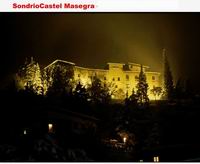 The Guicciardi palace which borders with the Sertoli Rajna Palace and the Romegially vicolo, is on the other hand, distinguished by an L-shaped plan. In this case as well, decorated and vaulted rooms have been preserved on the ground floor. On the other hand, beyond a few preserved Lombardy ‘cotto’ floors, it seems that extensive works were carried out in the 19th century in the two upper floors, perhaps when the palace was the headquarters of the Registry Office. In the Eastern wing, however, elegant pictorial decorations frame and connect the windows on the external facades. The Guicciardi palace which borders with the Sertoli Rajna Palace and the Romegially vicolo, is on the other hand, distinguished by an L-shaped plan. In this case as well, decorated and vaulted rooms have been preserved on the ground floor. On the other hand, beyond a few preserved Lombardy ‘cotto’ floors, it seems that extensive works were carried out in the 19th century in the two upper floors, perhaps when the palace was the headquarters of the Registry Office. In the Eastern wing, however, elegant pictorial decorations frame and connect the windows on the external facades.
Carbonera Palace : With its nice Renaissance facade, the Carbonera Palace is one of the most interesting aristocratic architectural pieces in Sondrio. The district where it is located, historically knows as “Cantone”, already existed in the Middle Ages. At that time the main road in the valley, the Via Valeriana, already crossed it. The “Cantone” constituted for centuries the only Western access point to the town as the only bridge over the Mallero was located at the Northern end of this area.
The Carbonera Palace, in comparison with surrounding houses that have undergone reconstructions and modifications throughout the centuries, has preserved noteworthy 16th-century architectural elements, at least in the North-Eastern part. The latter section has windows mounted by broken tympanums and capitals similar to those of early 16th century buildings, including the Besta Palace and Tirano’s sanctuary, which revealed a more up-to-date style than Bramante-like ones.
This wing of the palace looks out into the inner courtyard with a portico whose colonnade is characterised by interesting, fluting capitals. A partially covered staircase enables to reach the first floor and its loggia where the number of arches doubles. The upper loggia can instead be reached through the interior of the building. On the upper section of this very facade, once can observe a lozenge graffiti decoration found in other 16th-century aristocratic residences in Valtellina.
From the first loggia, it is possible to reach, thanks to two small portals, two halls covered by ‘lunette’ barrel vaults. One of the halls is distinguished by wall paintings with peculiar castle architecture and the date 1631 repeated twice. The beautiful ‘stua’ (wooden room) part of the itinerary of Milan’s Bagatti Valsecchi palace comes instead from the second hall of the palace.
Sondrio is set at the mouth of Mallero, a stream coming down from Valmalenco and flowing into river Adda.
The surrounding landscape is unique, characterized by the terraced vineyards supported by dried stonewalls, a magnificent work made by man in order to pull the soil to cultivate out off the mountain.
The municipalities in the southern part of the area belong to the Orobie Valtellinesi Park, a protected environment full of itineraries for trekking and mountain bike.
In Caiolo, 5 km far from Sondrio, a really beautiful golf green- 18 holes – is available.
A few kilometres far from Sondrio, Valmalenco is located in a landscape dominated by the mountainous groups of Disgrazia, Bernina and Pizzo Scalino. Chiesa in Valmalenco, Caspoggio and Lanzada constitute a tourist area with good hotel, leisure ans sport facilities: alpine skiing and cross-country skiing during the winter period, while during summer, trekking, mountaineering from one shelter to the other and ascensions. All this is set in a naturalistic, historical and ethnographic context of excellent worth. Furthermore, indoor swimming-pool, tennis courts and sports facilities offer you the opportunity to spend an amusing and relaxing holiday.
Morbegno, Valtellina's gates
When from the Lake Como you enter the territory of Valtellina, you meet the wide green valley floor which to the north is surrounded by Raetic Alps and to the south by the Orobie Prealps: that is Porte di Valtellina.
The main town you meet while going through the bottom of the valley is Morbegno, a municipality full of evidences of a rich and important past that can satisfy the visitor's historic-artistic interest.
 Morbegno's historic centre: In 1337 Morbegno was born with the laying of the first stone in the Santi Pietro e Paolo parish church, not too far away from the Bitto stream. Morbegno's historic centre: In 1337 Morbegno was born with the laying of the first stone in the Santi Pietro e Paolo parish church, not too far away from the Bitto stream.
During the years in which the village was developing soem noble families began to settle there, as the Gaifassi Family and The Castelli Sannazaro Family, the one that would have deeply marked the history of this area throughout the ages.
Under the Visconti, Morbegno dominates on the Terziere Inferiore of Valtellina. From this period to the 15th century the village goes through a period of discreet wealth. According to some visitors of the epoch Morbegno was: "Defended by walls and boasting Gothic style magnificent buildings". Among the ancient streets, the Via Ninguarda has maintained throughout the ages its original medieval planimetry. All along the road there are many interesting buildings.
The ex Presentazione Convent, for instance, that hosted the enclosed nuns and was also the best girls' school for the young girls coming from the Valtellinese aristocracy. And Casa Ninguarda, refined by a beautiful portal and wrought iron rococo style balconies, that gave birth to the bishop Feliciano Ninguarda, a Dominican, reforming Catholic and apostolic messenger in southern Germany.
At the end of Via Garibaldi, at last, an interesting 15th century fresco can be admired: it reproduces the "Madonna col Bambino" and a scene about the life of Saint Giuliano Ospitaliere which both show many reminiscences of the late-Gothic period. Among the numerous buildings the following ones are of particular worth: Palazzo Malacrida, Folcher, Melzi di Cusano, Malaguccini, Martinelli, Caccia Dominioni, Ciapponi and Casa Mariani.
By the orographic left side of river Adda the Orobiche Valleys can be observed: Val Tartano, Val Lesina and Bitto Valleys- Albaredo and Gerola- with their unique landscapes immersed in green mountain pastures and alpine little lakes. While on the opposite side there are the sunny slopes of the Costiera dei Chèch.
During winter you will find the Val Gerola ski area which has recently restored and updated its ski-lifts.
The "Open Air" sports lovers can breathe, among thick pinewoods, the silence of a really suggestive nature.
On the Raethic slope the beginning of the terraced vineyards can be observed. They give shape to the Costiera dei Cèch, in perfect harmony with the rural architecture, the nobiliar palaces and the holy buildings.
High peaks, granite walls, tops and crests originate the breathtaking panorama of Valmasino, a true paradise for the alpinists. During summer this valley offers the opportunity to have health and wellbeing thanks to Valmasino's ancient thermal baths.
To see in this southern part of the valley:
Palazzo Malacrida: Palazzo Malacrida is a nobiliary eighteenth-century building, work by the architect Pietro Solari di Bolvedro, which, majestic and imponent, dominates the town of Morbegno. It boasts an imposing staircase whose vault is painted with the scene of the "Ratto di Ganimede" by Giovan Pietro Romegialli.
On the main floor you can visit what follows: the honour hall decorated with architectural perspective drawings and trompe-l'oeil by Giuseppe Coduri, a painter of quadrature from Como, with 6 beautiful stucco balconies and a fresco ceiling realized by Cesare Ligari in 1761; the adjacent room hosting the "Tre Grazie" medallion still by Ligari; the alcove decorated by Coduri with floral designs and false architectural elements, that gives onto a loggia offering a stunning panorama on Bassa Valtellina; the gallery and a room hosting some paintings by Romegialli. A walkway allows to go from the second floor to the garden at the back of the building which are placed on 3 gradually descending terraces, from where the view stretches on the village of Morbegno and the valley as far as the Costiera dei Cèch. The ancient wine cellars, open to the public during the event "Morbegno in Cantina" usually taking place on the first two weekends in October, are worth a visit, too.
It is possible to visit the building by contacting in advance the town council of Morbegno or the Tourist Consortium Porte di Valtellina for guided visits.
Peregalli Nobiliary Building: In Delebio the Peregalli's history began in 1577 when Antonio Pregalli (Pelegalus) came downhill from the small mountain hamlet of Gerola to take up his residence here for good.
In this village of the Bassa Valle, thanks to a modern entrepreneurship, its family quickly reached the power up to come to play a leading role in the economic, cultural and artistic life of the village. The family's golden period can be set between the end of the 17th century and the first half of the 18th century. The building's restoration dates back to this period: it was erected on the ruins of a Cistercian grange and made comfortable and refined at the beginning of 1687, according to the will of Giovanni Pietro, a notary and good jurisconsult.
Yet it is from another wedding, the one between the Captain Giovanni Pietro II and his cousin Elisabetta Malacrida, that the international rococo jewel - San Gerolamo Oratory- was born. The Peregali Family's name is strictly linked to Valtellina's pre-industrial history: in fact they were the first ones to build up the very first factory in the province for silk working, a factory that lasted even more than the alienation of their goods (1857) till the beginning of the twentieth century and that offered work to many families in the Bassa Valle.
Palazzo Folcher and Palazzo Melzi: Some buildings raise to the nobility Piazza Tre Novembre: Casa Gusmeroli, which presents interesting graffiti decorations and a neogothic portal, and Palazzo Folcher. The last one shows off the most elegant façade of the historic centre, characterized by beautiful stone balconies dating to the Baroque period and by refined nineteenth-century stucco decorations. In this building now there is the historic café that between the nineteenth century and the twentieth century represented an important meeting point for the Morbegnese élite. Its renowned cellar is usually open on the occasion of the event "Morbegno in Cantina". Next to Palazzo Folcher there is the beautiful blue painted façade of Palazzo Melzi di Cusano (Delfino), which hosts the San Giuseppe Chapel- open to the public on the occasion of the Sacra Processione of Corpus Domini- and numerous rooms with decorations belonging to a period comprised between the eighteenth century and the early twentieth century. Even the young Angelika Kaufmann - who was destined to become the greatest European painter in the Neoclassical period - entered this building in order to paint some portraits.
Ciapponi Family House: Located in the middle of Piazza Tre Novembre and famous for the traditional grocer's shop specialized in the Bitto cheese storing, Casa Ciapponi probably has sixteenth-century origins.
Besides the beautiful and ancient signs of the shop, the house preserves a reproduction of an ancient clock that had been in there ( this square was called Piazza dell'Orologio ) and has been replaced at the end of the twentieth century. A fresco placed on the house corner that reproduces the Sacra Famiglia is of great importance: that is a work realized by the painter Giovanni Gavazzeni, prominent exponent of Valtellina's nineteenth century. The fresco is surprising because of the domestic atmosphere confered with masterly skill by the painter and it conceals in the face of the beautiful Lady the features of Gavazzeni's wife, Rosa Pirola.
The wine cellars that develop on different floors of F.lli Ciapponi's shop- where it is possible to taste the local products- are very characteristic and unique.
La Valchiavenna
Valchiavenna stretches North from the top of Lake Como in the hearth of Raethic Alps and, in Chiavenna- town of great past- it divides itself into two valleys which lead to the Maloja and Spluga passes at the border with Switzerland respectively.
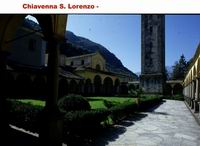 Valchiavenna is a long valley you reach turning towards North as soon as you enter the province Of Sondrio, coming from the Como Lake. It stretches from the Pian di Spagna to the Spluga Pass and borders the Swiss Cantone dei Grigioni by three sides ( Engadina, Val Bregaglia, Val Mesolcina). Valchiavenna is a long valley you reach turning towards North as soon as you enter the province Of Sondrio, coming from the Como Lake. It stretches from the Pian di Spagna to the Spluga Pass and borders the Swiss Cantone dei Grigioni by three sides ( Engadina, Val Bregaglia, Val Mesolcina).
The ways of access to Valchiavenna are two which are open all the year: from south through the Como Lake, from north through the Villa di Chiavenna Pass. During summer Spluga Pass is open, too. Crossing Valtellina the Aprica Pass and the Tirano Pass to Switzerland are the other passes open all the year.
Ancient traces of Valchiavenna’s noble past are still evident from its historical palaces.
The majority of which are located in the town of Chiavenna. One cannot forget to mention the Vertemate Franchi palace, one of the most prestigious Renaissance residential palaces in Lombardy; here the memory of the ancient town of Piuro has survived.
There a number of palaces that you will be able to admire while walking around Chiavenna’s historic centre or the town of Prosto di Piuro including:
Vertemate Franchi palace: one of the most prestigious Renaissance residential palaces in Lombardy where the memory of the ancient town of Piuro, submerged by a landslide in 1618, has survived.
Balbiani Palace: known as the Castle, it appears as a compact, stone bloc surrounded by two cylindrical towers.
Pestalozzi Palace: 15°-century palace, in whose interior is possible to admire a beautiful stüa (stove).
Pretorio Palace: Painted with frescoes on both the outside and inside.
Salis Palace: Stunning 18th-century villa surrounded by a wonderful English-style garden.
Valtellina's nature
Valtellina is a great green park in the heart of the Alps.
Many are the protected areas and the natural oasis in this area. The most popular ones are undoubtedly the Stelvio National Park and the Orobie Valtellinesi Park, but you don't need to go too far from the main roads to discover unique and extraordinary landscapes.
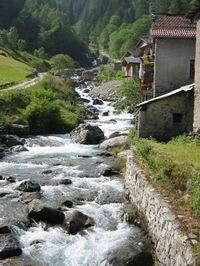 The wide natural scenery of the valley allow you to satisfy the desire of pure air and of walks in an extremely beautiful environment that had always inspired a lot of artists and writers. The wide natural scenery of the valley allow you to satisfy the desire of pure air and of walks in an extremely beautiful environment that had always inspired a lot of artists and writers.
The first step of your holiday in Valtellina might be through the knowledge its valleys and peaks.
For the nature lovers, there is a lot to choose from the numerous parks and reserves of the valley.
Valchiavenna, for example, proposes many itineraries immersed in the luxuriant nature of the Alps, as well as other itineraries in order to discover its rich history.
In Bassa Valtellina two are the main protected areas: the Park of the Orobie Valtellinesi and the Natural Oasis of Pian di Spagna.
The natural parks in Sondrio and Valmalenco are extraordinary. You can admire landscapes, watch animals and characteristic flowers in their natural habitat.
Media Valtellina offers the tourists its most stunning environmental beauties. A patrimony which is entirely to discover.
Alta Valtellina is synonymous with nature, uncontaminated environments and oasis of peace where it is still possible to immerse in the life of the Earth and to feel Her hearth beating.
In this land even flora and fauna assume different characteristics and colours according to the height above sea level in which they are.
They stretch from the spectacular vineyard terraced systems spread in the valley floor to go uphill through chestnut woods, maples, oaks and lindens, to reach finally an altitude of about 2000 meters, where the vegetation is characterized mainly by bushes - rhododendron, juniper and blueberry.
The rocks and the glaciers allow the tourist to become acquainted with the ancient history of this land. The mineralogical museums spread in the valley store a wide and detailed variety of the typical rocks of this area. Even the glaciers offer a really exciting example of the signs left in the past time in Valtellina.
And then there is water, with lakes and rivers. In Valtellina the presence of this element is so important that it is possible to count hundreds of streams and a moltitude of alpine lakes. These are charming places and represent the ideal destination for anyone who loves walking and sunbathing by the side of a mirror made of crystalline water.
A precious patrimony to be discovered also in Valtellina's thermal spa centres.
Snow in Valtellina
Valtellina's skiing district develops on over 450 kilometres of slopes, provided with about 140 ski lifts and equipped with modern structures with a system of planned snowfalls and ski-schools.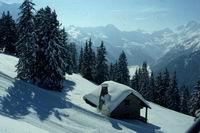 A lot of skiing resorts offer all the snowboarders numerous reserved areas - the snowparks - including various structures to do acrobatics on the snow. In addition you can also find endless cross-country skiing trails, alpinistic skiing itineraries and many other trails you can discover on "ciaspole". The winter furthermore offers the opportunity try out the numerous skate rinks -many of which are indoor- and the routes for dog-sledging, the sleigh hauled by dogs. Livigno, Bormio, Santa Caterina, Valdidentro, Madesimo, Aprica, Chiesa in Valmalenco, Valgerola and Teglio are the most famous ski areas in Valtellina. A lot of skiing resorts offer all the snowboarders numerous reserved areas - the snowparks - including various structures to do acrobatics on the snow. In addition you can also find endless cross-country skiing trails, alpinistic skiing itineraries and many other trails you can discover on "ciaspole". The winter furthermore offers the opportunity try out the numerous skate rinks -many of which are indoor- and the routes for dog-sledging, the sleigh hauled by dogs. Livigno, Bormio, Santa Caterina, Valdidentro, Madesimo, Aprica, Chiesa in Valmalenco, Valgerola and Teglio are the most famous ski areas in Valtellina.
Summer in Valtellina
You can discover the charm of the mountain in any period of the year in Valtellina. During summer then you can do summer skiing at Stelvio Pass, going on with an excursion which will allow you to plunge into the green or with a ride on your mountain bike which will make you discover countless valleys. While in winter there is no better suggestion than such a wide range of skiing resorts surrounded by extraordinary natural settings which offer the opportunity to play all winter sports.
That is your holiday in Valtellina, in search of extraordinary experiences.
Food and wine
 In Valtellina your holiday is not completed if you don't taste the products of the cuisine. In Valtellina your holiday is not completed if you don't taste the products of the cuisine.
This land's gastronomic history is strictly linked with the country environment and the rustic tradition. The popular pastures cheeses - Bitto and Casera- are perfectly combined with Valtellina's unique wines, one of them, for insance, is Sforzato.
Bresaola and pizzocheri (black flour noodles) are other symbol products of this land and also represents the ideal beginning for a pleasant journey in order to discover many other food joys, such as the valley's apples and honey.
Furthermore there are the traditional recipes and the right places where to taste them. Here are some suggestions.
Sciatt Small pancakes made from black flour, filled with Casera cheese. In Valtellina's dialect they means "toad", a bizarre name due to to their irregular shape. They are served with salad and a good glass of red wine.
Chisciöi Tirano's area traditional specialty, black flour- based, less popular than pizzocheri and sciatt. It is a kind of very delicious focaccia bread or pancake to be prepared with Valtellina's original local products.
Bisciola Valtellina's rustic cake made of nuts, figs and raisins which is served either as it is or with vanilla sauce or a sauce made from Braulio, the Valtellina's renowed liqueur. It might be an ideal sweet to bring back home to recollect the savours of a special holiday.
 Goat ViolinThe most typical specialty in Valchiavenna. The Violin is a mature and smoked ham which is obtained from the leg or the shoulder of the goat. It is sliced as if playing a musical instrument, putting it near the neck and using a knife instead of the bow. Goat ViolinThe most typical specialty in Valchiavenna. The Violin is a mature and smoked ham which is obtained from the leg or the shoulder of the goat. It is sliced as if playing a musical instrument, putting it near the neck and using a knife instead of the bow.
Prosto Biscuits For hundreds and hundreds years it has been a very popular product on Valchiavennasche's tables. Simple ingredients- wheat flour, sugar and butter- have been combined togheter by the Del Curto's family with an incomparable result. Packages are usually handmade with a special coloured paper wrap.
Rye bread Forget rosetta bread and white bread. A ring-shaped black cake, rye bread represents the most popular food on Valtellinese cuisine. It is usually slightly covered with white flour. It perfectly matches with salami and cheeses, as well as with jam and honey.
Taroz Valtellina's traditional dish made of vegetables cultivated also in the mountain. It is a single dish composed by mashed potatoes mixed with beans and French beans,which are abudantly seasoned with Valtellina's butter and cheese.
Crotti Cellars vaults formed under the stone blocks caused by landslides. From here the "sorel" blows, a constant temperature draught, which contributes to the wine ripening and to the aging of cheeses, salami and hams. They are in Valchiavenna: some of them are open to the public and have been transformed into restaurants where a genuine cuisine is prepared.
TEXTS AND PHOTOS ARE PUBLISHED WITH GENTLE PERMIT OF "PROVINCIA DI SONDRIO" - TOURIST OFFICE
|



 Munch: The Scream Within
Munch: The Scream Within In the garden
In the garden Perugia Travel Guide
Perugia Travel Guide


 The valley develops from east to west and has a longitudinal aspect which is the most extended one in the whole Alpine arc. It is totally crossed by the National road number 38, known as "Statale dello Stelvio".
The valley develops from east to west and has a longitudinal aspect which is the most extended one in the whole Alpine arc. It is totally crossed by the National road number 38, known as "Statale dello Stelvio". The River Adda that flows into the lake Como runs through the valley.
The River Adda that flows into the lake Como runs through the valley. The Guicciardi palace which borders with the Sertoli Rajna Palace and the Romegially vicolo, is on the other hand, distinguished by an L-shaped plan. In this case as well, decorated and vaulted rooms have been preserved on the ground floor. On the other hand, beyond a few preserved Lombardy ‘cotto’ floors, it seems that extensive works were carried out in the 19th century in the two upper floors, perhaps when the palace was the headquarters of the Registry Office. In the Eastern wing, however, elegant pictorial decorations frame and connect the windows on the external facades.
The Guicciardi palace which borders with the Sertoli Rajna Palace and the Romegially vicolo, is on the other hand, distinguished by an L-shaped plan. In this case as well, decorated and vaulted rooms have been preserved on the ground floor. On the other hand, beyond a few preserved Lombardy ‘cotto’ floors, it seems that extensive works were carried out in the 19th century in the two upper floors, perhaps when the palace was the headquarters of the Registry Office. In the Eastern wing, however, elegant pictorial decorations frame and connect the windows on the external facades. Morbegno's historic centre: In 1337 Morbegno was born with the laying of the first stone in the Santi Pietro e Paolo parish church, not too far away from the Bitto stream.
Morbegno's historic centre: In 1337 Morbegno was born with the laying of the first stone in the Santi Pietro e Paolo parish church, not too far away from the Bitto stream. Valchiavenna is a long valley you reach turning towards North as soon as you enter the province Of Sondrio, coming from the Como Lake. It stretches from the Pian di Spagna to the Spluga Pass and borders the Swiss Cantone dei Grigioni by three sides ( Engadina, Val Bregaglia, Val Mesolcina).
Valchiavenna is a long valley you reach turning towards North as soon as you enter the province Of Sondrio, coming from the Como Lake. It stretches from the Pian di Spagna to the Spluga Pass and borders the Swiss Cantone dei Grigioni by three sides ( Engadina, Val Bregaglia, Val Mesolcina). The wide natural scenery of the valley allow you to satisfy the desire of pure air and of walks in an extremely beautiful environment that had always inspired a lot of artists and writers.
The wide natural scenery of the valley allow you to satisfy the desire of pure air and of walks in an extremely beautiful environment that had always inspired a lot of artists and writers. A lot of skiing resorts offer all the snowboarders numerous reserved areas - the snowparks - including various structures to do acrobatics on the snow. In addition you can also find endless cross-country skiing trails, alpinistic skiing itineraries and many other trails you can discover on "ciaspole". The winter furthermore offers the opportunity try out the numerous skate rinks -many of which are indoor- and the routes for dog-sledging, the sleigh hauled by dogs. Livigno, Bormio, Santa Caterina, Valdidentro, Madesimo, Aprica, Chiesa in Valmalenco, Valgerola and Teglio are the most famous ski areas in Valtellina.
A lot of skiing resorts offer all the snowboarders numerous reserved areas - the snowparks - including various structures to do acrobatics on the snow. In addition you can also find endless cross-country skiing trails, alpinistic skiing itineraries and many other trails you can discover on "ciaspole". The winter furthermore offers the opportunity try out the numerous skate rinks -many of which are indoor- and the routes for dog-sledging, the sleigh hauled by dogs. Livigno, Bormio, Santa Caterina, Valdidentro, Madesimo, Aprica, Chiesa in Valmalenco, Valgerola and Teglio are the most famous ski areas in Valtellina. In Valtellina your holiday is not completed if you don't taste the products of the cuisine.
In Valtellina your holiday is not completed if you don't taste the products of the cuisine. Goat ViolinThe most typical specialty in Valchiavenna. The Violin is a mature and smoked ham which is obtained from the leg or the shoulder of the goat. It is sliced as if playing a musical instrument, putting it near the neck and using a knife instead of the bow.
Goat ViolinThe most typical specialty in Valchiavenna. The Violin is a mature and smoked ham which is obtained from the leg or the shoulder of the goat. It is sliced as if playing a musical instrument, putting it near the neck and using a knife instead of the bow.